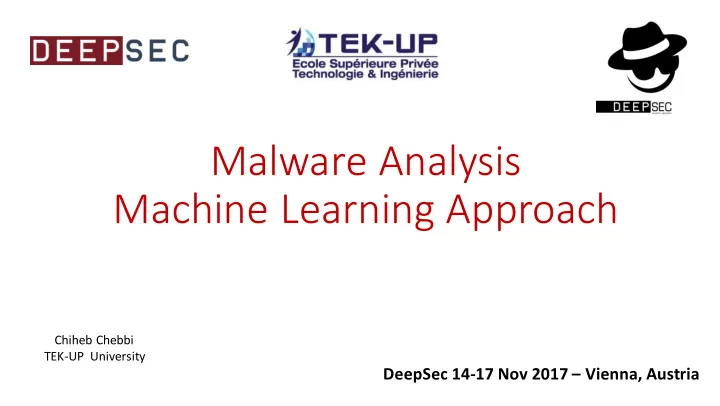

Malware Analysis Machine Learning Approach Chiheb Chebbi TEK-UP University DeepSec 14-17 Nov 2017 – Vienna, Austria
<whoami/> • Computer science engineering student @TEK-UP • Cyber security leadership program fellow @Kaspersky_Lab • Author / Technical Reviewer @Packt_Publishing UK • Invited as a speaker to: Besides Tempa Florida2017, BH Europe 2016,NASA SAC ...
Source: State of Malware Report 2017- MalwareBytes LABS
Source: State of Malware Report 2017- MalwareBytes LABS
Ransomware 49 % Android Malware 31 % Adware 37 % Source: State of Malware Report 2017- MalwareBytes LABS
Malware Analysis Techniques Static Analysis the examination of the malware sample without executing Dynamic Analysis Dynamic analysis techniques track all the malware activities Memory Analysis the act of analyzing a dumped memory image from a targeted machine after executing the malware
Source: McAfee Labs, 2017.
Machine Learning Artificial Intelligence Ability to perform tasks normally requiring human intelligence, such as visual perception, speech recognition Machine Learning the study and the creation of algorithms that can learn from data and make prediction on them
Machine Learning Models Supervised Learning we have input variables (I) and an output variable (O) and we need to map the function Decision Trees, Nave Bayes Classification, Support Vector Machines Unsupervised learning we only have input data (X) Reinforcement the agent or the system is improving its performance based on a reward function
Hot Dog OR Not Hot Dog
Machine Learning Workflow
Malware Datasets Malware Analysis Process Entry Points: • File • URL • PCAP • Memory Image
Hidden Markov Models Markov process or what we call a Markov chain is a stochastic model used for any random system that change its states according to fixed probabilities In probability theory and related fields, a stochastic or random process is a mathematical object usually defined as a collection of random variables
Hidden Markov Models • The Hidden Markov Model is a Markov Process where we are unable to directly observe the state of the system. Each state has a fixed probability of ”emitting”. p is a sequence of states (AKA a path). Each p i takes a value from set Q. We do not observe p
Hidden Markov Models
Hidden Markov Models
Classic Problems of Hidden Markov Model • Problem 1: State Estimation Given a model λ = ( A , B , Π ) and an observation sequence O, we need to find P(O —λ).That is to determine the likelihood and check the wellness of the given model. • Problem 2: Decoding or Most Probable Path (MPP): Given a model λ = ( A , B , Π ) and ,and an observation sequence O, to determine the optimal state sequence Q for the given model • Problem 3: Training/Learning HMM: Given O, N, M, we can find a model that maximizes probability of O and learn the two HMM parameters A and B.
Solutions • Forward-Backward technique • Viterbi Decoding technique • Baum-Welch (Expectation Maximization) technique
Profile Hidden Markov Model • By definition a profile is a pattern of conservation. The Profile Hidden Markov Model is a probabilistic approach that was developed specially for modeling sequence similarity occurring in biological sequences such as proteins and DNA. • Profile HMM is a modified implementation of HMM.
• HMMER is an open source implementation of Profile Hidden Markov Models. It is basically built to build HMM models for protein sequences and alignment but in our case we are going to adopt it to build models for malware behaviour sequences.
Machine learning Model Evaluation Metrics tp = True Positive fp = False Positive tn = True Negative fn = False Negative Confusion Matrix
Low Detection Rate :'(
One Algorithm Hypothesis • There is some evidence that the human brain uses essentially the same algorithm to understand many different input modalities. • Ferret experiments, in which the “input” for vision was plugged into auditory part of brain, and the auditory cortex learns to “see.” [Roe et al., 1992]
“Look deep into nature, and then you will understand everything better.” Albert Einstein
• The artificial model of a neuron is called perceptron
Backpropagation Backpropagation is the process of trying to keep the error as down as possible. Stochastic Gradient Descent
Microsoft Malware Classification Challenge (BIG 2015) 10K Malware 500 GB
• Accurately detects malware at > 90%
Well documented and open source frameworks
Deep learning life-cycle • Network Definition • Network Compiling • Network Fitting • Network Evaluation • Prediction
Machine Learning vs Deep Learning
Gartner report: “Intelligent and Automated Security Controls Impact the Future of the Security Market”, Oct 2015
• Machine learning in cybersecurity will enormously booster spending in big data, intelligence and analytics, reaching as much as $96 billion (£71.9 billion) by 2021.
References [1] Defeating Machine Learning What Your Security Vendor is Not Telling You – Blackhat USA 2015 [2] Deep Learning for Malware Analysis Machine Learning for Computer Security Hugo Gascón [3] State of the art MalwareBytes Report 2017 [4] Deep Machine Learning Meets Cybersecurity [5] How to build a malware classifier [that doesn't suck on real-world data]
Q&A Chiheb-chebbi@outlook.fr Chiheb.chebbi@tek-up.de Hello@chihebchebbi.tn
Recommend
More recommend